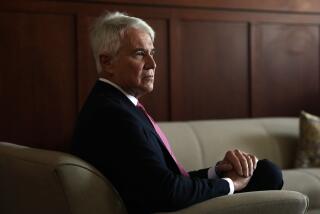Famed Manson family prosecutor Vincent Bugliosi dies at 80
Near the close of the 1960s, everyone who kept up with the news knew who Charles Manson was, but hardly anyone had heard of Vincent Bugliosi.
Bugliosi, however, didn’t remain obscure for long: The ambitious Los Angeles County deputy district attorney soon gained worldwide fame for his central role in prosecuting the bizarre murders that terrorized California in the summer of 1969.
Two years later, Bugliosi won the convictions of mastermind Manson and the followers who carried out the Tate-LaBianca killings. Then he used his celebrity to launch a career as a bestselling author, beginning with “Helter Skelter,” his account of the Manson case that has sold more than 7 million copies.
With a lawyer’s cool, he went on to write books on subjects as contentious as George W. Bush’s conduct of the Iraq war and the existence of God. But he never shook his primary legacy — nor tired of the glory.
“No matter what I do, I’ll be forever known as the Manson prosecutor,” he told The Times in 1994.
Bugliosi died of cancer Saturday at a Los Angeles hospital, said his wife, Gail. He was 80.
All but one of the defendants in the Manson family trials he handled have outlived him, including Manson himself, who turned 80 in November.
------------
For the record 6/10 2:16 p.m.: An earlier version of this story omitted the first name of murder victim Sharon Tate.
------------
The events leading to the sensational case began on the night of Aug. 8, 1969, when, acting on Manson’s orders, four of the cult leader’s followers drove to the Hollywood Hills, ending up around midnight at the secluded Benedict Canyon estate Sharon Tate shared with her husband, director Roman Polanski, who was out of the country.
Five people, including the pregnant Tate, would be stabbed or shot to death on the sprawling property. Tate, who begged for her life and that of her nearly full-term baby, was also hanged.
The other victims at the Tate residence or on the grounds were Hollywood hairstylist Jay Sebring, 35; Voytek Frykowski, 32, a friend of Polanski’s; Abigail Folger, 25, a coffee heiress and girlfriend of Frykowski; and Steven Parent, 18, who had been visiting the property’s caretaker.
Hours later, across town in Los Feliz, grocery chain owners Leno and Rosemary LaBianca were tied up, tortured and killed in a similar manner inside their home.
Breathtaking in their brutality, the multiple killings set the region on edge. Gun sales skyrocketed in Beverly Hills and nearby communities. Business boomed for security firms, and off-duty police were hired to patrol the homes of the wealthy.
Aided by a jailhouse tip, investigators would eventually link the murderous rampage to Manson and several of his followers living on a remote former movie ranch above Chatsworth.
Bugliosi had been in the L.A. County district attorney’s office just five years when he was asked to help build the case against Manson and those accused with him: Susan Atkins, Patricia Krenwinkel and Leslie Van Houten. (Another defendant, Charles “Tex” Watson, would be tried separately.)
Two months into what would become a nearly 10-month trial — a record length and, at $1 million, a record cost for its time — Bugliosi became the chief prosecutor on the Manson case after a more senior attorney was removed by the district attorney’s office for making public comments about it.
In “Helter Skelter,” Bugliosi recalled his surprise the first time he saw Manson. “I hadn’t realized how small he was,” he wrote of the slim man who stood a little over 5 feet tall. “I could not believe that this little guy had done all the things it was said he had. He looked anything but a heavyweight. Yet I knew that to underestimate him would be the biggest mistake I could make.”
The courtroom proceedings were marked by the defendants’ bizarre behavior: Manson and the women known as his “girls” carving Xs in their foreheads and shaving their heads; other members of the Manson “family” holding vigil outside the downtown L.A. courthouse; Manson lunging at Judge Charles Older with a sharpened pencil. Bugliosi was assigned a bodyguard after Manson threatened to kill him.
Bugliosi argued before jurors that the motive for the murders was Manson’s bizarre plan to trigger a race war called Helter Skelter from a Beatles song of the same name. The prosecutor said the cult leader believed that blacks would win the war but would eventually hand over power to Manson and his all-white followers, who planned to survive the carnage by hiding out in Death Valley.
When Bugliosi made his final arguments in the trial, The Times noted that he “used sarcasm, facetious remarks, vivid examples, florid language and arm-waving histrionics to present a meticulous, hard-hitting rebuttal to defense claims.”
In 1971, juries found Manson, Atkins, Krenwinkel and Watson guilty on seven counts of first-degree murder. Van Houten was convicted of two murders.
Bugliosi sought and won death sentences for all five defendants, but the sentences were reduced to life in prison after the California Supreme Court abolished the death penalty in 1972. (The Legislature later reenacted the death penalty statute, but the life terms for the Manson defendants were unchanged.) Atkins died in prison in 2009; the others remain behind bars.
Stephen R. Kay, a former Los Angeles County deputy district attorney who worked with Bugliosi on the Manson trial, said the chief prosecutor recognized the significance of the case from the beginning in a way Kay, then 27, and at least some others in the office did not.
“Another attorney had told me, ‘This is just another big case and in five years, everyone will forget about it,’” Kay said in a 2012 interview with The Times. “But Vince really understood the potential all along, that this was the case of a career.”
In the course of the trial, Bugliosi quietly engaged a writer, Curt Gentry, to work with him on crafting “Helter Skelter,” a detailed account of the murders and the complex court case, published in 1974.
Vincent T. Bugliosi was born in Hibbing, Minn., on Aug. 18, 1934, the son of Ida and Vincent Bugliosi Sr. His father ran a small grocery store and was later employed as a railroad conductor.
Bugliosi earned money as a youngster by mowing lawns, delivering newspapers and other small jobs. He also excelled at tennis, winning a state championship in Minnesota when he was 16. His family later moved to Los Angeles, and Bugliosi graduated from Hollywood High School.
He attended the University of Miami on a tennis scholarship, earning a bachelor’s degree in business administration. He later received a law degree from UCLA, where he was president of his 1964 graduating class.
In 1956, he married Gail Talluto, whom he had met in college. He is survived by his wife; a daughter, Wendy; and a son, Vincent.
After the Manson trial propelled him into the limelight, Bugliosi ran twice for Los Angeles County district attorney, losing both times.
After leaving the district attorney’s office, Bugliosi became a defense attorney but accepted relatively few cases. “I just don’t want to defend the same kind of people I used to send to death row,” he told the Duluth News-Tribune in 2001.
Mainly, he wrote books, more than a dozen in all, sometimes with co-authors, and always the same way, in longhand, on a yellow legal pad.
In 1996, he published “Outrage: The Five Reasons Why O.J. Simpson Got Away with Murder,” in which he dug through the details of the case against Simpson in the deaths of his ex-wife, Nicole Brown Simpson, and her friend Ronald Goldman. Bugliosi castigated the prosecutors and judge who handled the case as all but incompetent.
In one section of the book, he asked how God could have allowed Simpson and Goldman to die and allow their killer to go free. “I, for one, can’t be sure at all there is a God,” he wrote. After hundreds of readers wrote to him — many wanting to save his soul — the longtime agnostic decided to tackle the ultimate existential mystery in his book “Divinity of Doubt: the God Question” (2011).
The book he considered his best was “Reclaiming History: The Assassination of President John F. Kennedy,” a 1,600-page volume published in 2007. In it, he examined the assassination and investigation in minute detail, scornfully dismissing the conspiracy theorists who questioned that Lee Harvey Oswald had committed the crime and that he acted alone.
But he remained most famous for “Helter Skelter.” Its meticulous detail and the author’s unique position as prosecutor made it an “indispensable contribution” to the dialogues spurred by the murders, critic Robert Kirsch wrote in his review for The Times. The book won an Edgar Allan Poe Award for the best work of true crime and spawned two TV movies, in 1976 and 2004.
Inevitably, most conversations with him turned to the Manson case.
“Years ago, I spoke at a book convention in Richmond, Va.,” Bugliosi told a Newsweek interviewer in 2009. “I arrived at the station at the same time as William Manchester and Arthur Schlesinger, both Pulitzer Prize winners. The whole cab ride, Manchester and Schlesinger are tossing me questions about Charles Manson: That’s all they wanted to talk about.”
After California’s high court declared the death penalty unconstitutional, Bugliosi saw Manson only once more. The convicted killer, who had spent many years in reform schools and prisons before the Tate-LaBianca murders, taunted the prosecutor for achieving nothing more than sending him “back to where I came from.”
“I hate to admit it,” Bugliosi told the Los Angeles Daily News decades later, “but, to a certain extent, Manson has beaten the rap.”
Believing that none of the Manson killers would ever be released, he did not attend their parole hearings. He did, however, soften his stance toward Atkins.
He had written in his book that jurors “had looked at the heart of Susan Atkins and seen ice.” But more than three decades on, when she was dying of cancer, he told reporters he did not object to her request for compassionate release.
“She has paid substantially, though not completely, for her horrendous crimes,” he told The Times in 2008, noting that she had by then spent 37 years in prison, renounced Manson and lost a leg to her illness. She died in prison.
Bugliosi was often asked to explain the enduring interest in the killings, which have been widely portrayed as the shuddering end of a chaotic decade of social change.
But the man who brought the killers to justice preferred a more prosaic explanation.
“The very name Manson has become a metaphor for evil....” Bugliosi told The Times in 1994. “He has come to represent the dark and malignant side of humanity, and for whatever reason, there is a side of human nature that is fascinated with ultimate evil.”
Trounson is a former Times staff writer.
More to Read
Start your day right
Sign up for Essential California for the L.A. Times biggest news, features and recommendations in your inbox six days a week.
You may occasionally receive promotional content from the Los Angeles Times.







